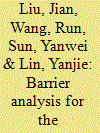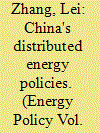|
|
|
Sort Order |
|
|
|
Items / Page
|
|
|
|
|
|
|
| Srl | Item |
| 1 |
ID:
124240


|
|
|
|
|
| Publication |
2013.
|
| Summary/Abstract |
Distributed energy (DE) is receiving lots of attention from the Chinese government. A number of DE projects have been constructed in China. However, there are still numerous problems with DE projects. What hinders the development of DE in China? The Huadian Jimei distributed energy project (HJDE) is a typical DE building project that was not completed successfully. This paper focuses on this DE project to explore the barriers to DE development. The research group conducted 13 semi-structured interviews with representatives of institutions and corporations involved in the HJDE project to collect information. Based on the information, three types of problems were determined, and the results indicate that these conflicts between the core stakeholders make DE projects unsuccessful. These problems result from institutional barriers to DE, rooting in the development policy and the current energy market. Moreover, several key stakeholders are not able to play an active role in the design or management of DE projects. The Chinese government will put a much greater effort into the development of future DE projects. Many national support policies and rules will be announced, which are easy to practical use. Under these conditions, 1000 DE projects will be successfully completed until 2015.
|
|
|
|
|
|
|
|
|
|
|
|
|
|
|
|
| 2 |
ID:
162945


|
|
|
|
|
| Summary/Abstract |
Distributed energy (DE) is a way to cascade energy use near multiple users. It significantly impacts energy savings, emission reductions and energy structure upgrades. In recent years, all levels of the Chinese government have strived to introduce policies favorable to the implementation of DE. These policies have been affected by the timing of the introduction, regional economic differences, the degree of government attention, and many other complex factors. To clarify the development and links between these policies, this study summarizes and compares China's DE policies at national, provincial, and municipal levels, from 1989 to 2016. We analyze the scope and content of subsidies in detail, and then provide policy recommendations for DE development in China. The main results are as follows: (1) DE policies emerge from legal provisions in the areas of energy, electricity, and environmental protection. The policies have gradually evolved from macro-plans to specific guidance. (2) The demand for DE subsidies is increasing, making the back slope of subsidies significant under an insufficient government budget. Diverse subsidies are needed to address this contradiction. (3) Future policies should focus on comprehensive DE utilization, smart grids, research and development (R&D), and developing policy synergies at different levels.
|
|
|
|
|
|
|
|
|
|
|
|
|
|
|
|
| 3 |
ID:
116941


|
|
|
|
|
| Publication |
2012.
|
| Summary/Abstract |
We present here economic findings from a major study by Australia's Commonwealth Scientific and Industrial Research Organisation (CSIRO) on the value of distributed energy technologies (DE; collectively demand management, energy efficiency and distributed generation) for reducing greenhouse gas emissions from Australia's energy sector (CSIRO, 2009). The study covered potential economic, environmental, technical, social, policy and regulatory impacts that could result from their wide scale adoption. Partial Equilibrium modeling of the stationary energy and transport sectors found that Australia could achieve a present value welfare gain of around $130 billion when operating under a 450 ppm carbon reduction trajectory through to 2050. Modeling also suggests that reduced volatility in the spot market could decrease average prices by up to 12% in 2030 and 65% in 2050 by using local resources to better cater for an evolving supply-demand imbalance. Further modeling suggests that even a small amount of distributed generation located within a distribution network has the potential to significantly alter electricity prices by changing the merit order of dispatch in an electricity spot market. Changes to the dispatch relative to a base case can have both positive and negative effects on network losses.
|
|
|
|
|
|
|
|
|
|
|
|
|
|
|
|
| 4 |
ID:
096632


|
|
|
|
|
| Publication |
2010.
|
| Summary/Abstract |
Grid parity-reducing the cost of solar energy to be competitive with conventional grid-supplied electricity-has long been hailed as the tipping point for solar dominance in the energy mix. Such expectations are likely to be overly optimistic. A realistic examination of grid parity suggests that the cost-effectiveness of distributed photovoltaic (PV) systems may be further away than many are hoping for. Furthermore, cost-effectiveness may not guarantee commercial competitiveness. Solar hot water technology is currently far more cost-effective than photovoltaic technology and has already reached grid parity in many places. Nevertheless, the market penetration of solar water heaters remains limited for reasons including unfamiliarity with the technologies and high upfront costs. These same barriers will likely hinder the adoption of distributed solar photovoltaic systems as well. The rapid growth in PV deployment in recent years is largely policy-driven and such rapid growth would not be sustainable unless governments continue to expand financial incentives and policy mandates, as well as address regulatory and market barriers.
|
|
|
|
|
|
|
|
|
|
|
|
|
|
|
|
| 5 |
ID:
149961


|
|
|
|
|
| Summary/Abstract |
This study presents a framework to quantitatively evaluate decentralized generation and storage technology (DGST) performance and policy impacts in a rural setting. The role of DGSTs in the future energy systems planning of a rural agglomeration in Switzerland is examined using a cost optimization modeling approach. Heat and electricity demand for major sectors are considered. Scenarios introduce DGSTs in a stepwise manner to measure incremental impacts on future capacity planning compared to a baseline scenario. Sub-scenarios also examine the impacts of carbon mitigation policies, and a sensitivity analysis is carried out for key energy carriers and conversion technologies. DGSTs enable a significant reduction in electricity grid usage for the community considered. Small hydro with a storage reservoir and photovoltaics enable the community to become largely self-sufficient with over 80% reductions in grid imports by 2050 compared to the baseline scenario. Storage enables maximum usage of the available hydro potential which also leads to network upgrade deferrals and a significant increase in photovoltaic installations. Investment decisions in small hydro are robust against cost variations, while heating technology investment decisions are sensitive to oil and grid electricity prices. Carbon pricing policies are found to be effective in mitigating local fossil fuel emissions.
|
|
|
|
|
|
|
|
|
|
|
|
|
|
|
|
|
|
|
|
|